Welcome to the world of cryptocurrency trading! We're going to assume you already have a basic understanding of what cryptocurrency trading is. If not, we recommend you to read our introductory article on “What are cryptocurrencies and how do they work” first.
In this guide, we're going to delve deeper into the mechanics of trading cryptocurrencies, specifically through Contracts for Difference (CFDs). Trading cryptocurrencies via CFDs allows you to speculate on the price movements of digital assets without actually owning them. This approach offers a unique set of advantages, which we will explore in the following sections. So, buckle up and get ready to dive into the exciting and dynamic world of cryptocurrency trading!
Discover the world of cryptocurrency trading with our step-by-step guide.
Take your skills further in a risk-free demo account or start trading with a real account today!
- What is Cryptocurrency Trading?
- How to Trade Cryptocurrency – A Step-by-step Guide
- What Moves Cryptocurrency Prices?
- How to Analyse the Cryptocurrency Markets
- Cryptocurrency Trading Strategies
- Why Trade Cryptocurrencies?
- Why Trade Cryptocurrencies with AvaTrade?
- Frequently Asked Questions (FAQs)
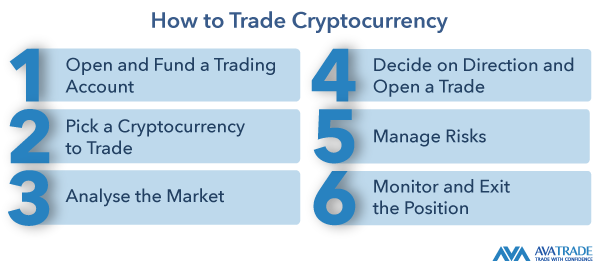
Trading cryptocurrencies might seem daunting at first, but once you break it down into steps, it becomes a straightforward process. Here's a step-by-step guide to get you started:
- Open and Fund a Trading Account: The first step in your trading journey is to open a trading account with a reputable broker like AvaTrade that offers cryptocurrency CFDs. Once your account is set up, you'll need to deposit funds. Most brokers offer various funding options, depending on the local regulation, including bank transfer, credit card, or even PayPal.
- Pick a Cryptocurrency to Trade: Next, decide which cryptocurrency you want to trade. You might choose Bitcoin or Ethereum, the most widely traded cryptocurrencies, or you might opt for a lesser known altcoin. Your choice should be based on your market research and personal trading goals.
- Analyse the Market: Before you open a trade, it's crucial to analyse the market. You can use fundamental analysis, which involves evaluating the overall health of the cryptocurrency's network, news events, and broader market trends. Alternatively, you can use technical analysis, which involves studying price charts to identify patterns and trends. Most successful traders use a combination of both.
- Decide on Direction and Open a Trade: Based on your market analysis, decide whether you believe the cryptocurrency will go up in value (buy) or down in value (sell), and open a trade. Remember, with CFDs, you can potentially profit whether the market is rising or falling.
- Manage Risks: It's important to have a risk management strategy in place. This could involve setting stop-loss orders to limit potential losses and take-profit orders to secure profits when the price reaches a certain level.
- Monitor and Exit the Position: Once your trade is open, you should monitor the market regularly to see how it's performing. You can close your position manually when you feel it's the right time, or you can set orders to close it automatically at a certain price level.
Remember, always start with a clear trading plan and try to avoid letting emotions dictate your trading decisions.
What Moves Cryptocurrency Prices?
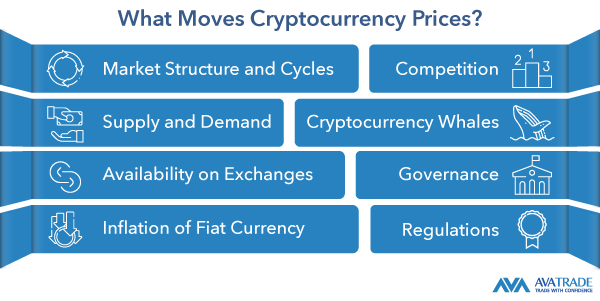
Understanding what drives the prices of cryptocurrencies can give you an edge in your trading decisions. Here are some key factors that influence cryptocurrency prices:
- Market Structure and Cycles – Just like other financial markets, the cryptocurrency market goes through cycles – periods of high growth followed by periods of correction. These cycles can be influenced by a variety of factors, including technological advancements, market sentiment, and macroeconomic trends. Understanding these cycles can help traders make informed decisions about when to enter or exit trades.
- Supply and Demand – The basic economic principle of supply and demand plays a significant role in cryptocurrency prices. If a particular cryptocurrency has a high token supply but low demand, the price will drop. On the other hand, if the supply of a cryptocurrency is limited and the demand is high, the price will increase.
- Availability on Exchanges – The more exchanges a cryptocurrency is listed on, the easier it is for people to buy and sell it, which can increase demand and, consequently, its price. Conversely, if a cryptocurrency is delisted from a major exchange, it could decrease in price due to reduced accessibility.
- Inflation of Fiat Currency – Cryptocurrencies, particularly Bitcoin, are sometimes seen as a hedge against inflation. When inflation rates for fiat (regular, government-issued) currencies are high, more people may choose to buy cryptocurrencies to protect their wealth, driving up prices.
- Competition – The cryptocurrency market is highly competitive, with thousands of cryptocurrencies in existence as of 2023. Competition can affect prices as cryptocurrencies vie for market share. If a new cryptocurrency offers superior technology or features, it could potentially drive down the prices of older, less efficient cryptocurrencies.
- Governance – The governance model of a cryptocurrency can also impact its price. Cryptocurrencies with clear, transparent governance models may be more appealing to investors, as they provide more predictability and stability.
- Regulations – Regulatory news can significantly impact cryptocurrency prices. Positive regulatory news can drive prices up, while negative news, such as a country banning cryptocurrency trading, can drive prices down.
- Cryptocurrency Whales – A “whale” in the cryptocurrency market is an individual or entity that holds a large amount of a cryptocurrency. Whales have the power to influence prices by buying or selling large amounts of a cryptocurrency.
By understanding these factors, you can gain a deeper insight into the market dynamics of cryptocurrencies and make more informed trading decisions.
How to Analyse the Cryptocurrency Markets
In the previous section, we discussed the fundamental factors that influence cryptocurrency prices. Now, let's switch gears and enter the world of technical analysis. Technical analysis involves using statistical trends gathered from trading activity, such as price movement and volume, to predict future price movements. Here are some key technical analysis tools that you can use to analyse the markets like a pro:
- Support and Resistance – These are the levels at which the price of a cryptocurrency tends to stop and reverse. Support is the price level at which demand is thought to be strong enough to prevent the price from falling further, while resistance is the price level at which selling is thought to be strong enough to prevent the price from rising further. Identifying these levels can help traders make decisions about when to buy or sell.
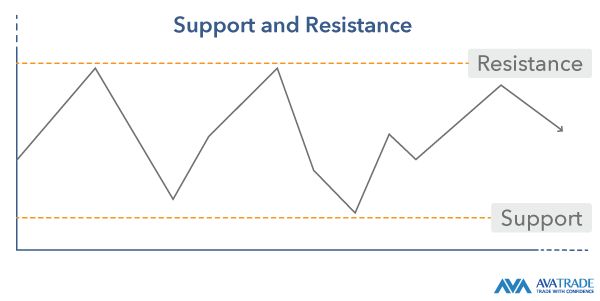
- Trendlines – Trendlines are simple, yet powerful tools in technical analysis. Imagine drawing a line that shows the general direction of a cryptocurrency's price – that's essentially a trendline. If the price generally goes up, we draw an upward line, and this line can help us predict that the price might continue to go up. If the price generally goes down, we draw a downward line, which can help us predict that the price might continue to go down. These lines help traders visually understand the current trend and make predictions about future price movements.
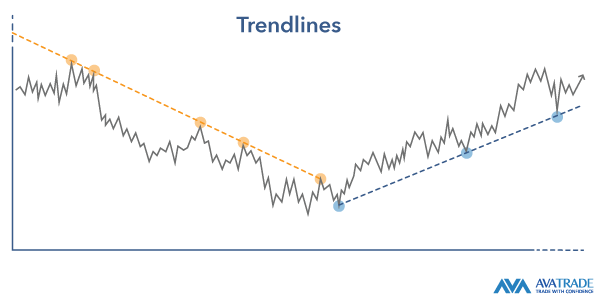
- Moving Averages – A moving average (MA) is a widely used indicator in technical analysis that helps smooth out price action by filtering out the “noise” from random short-term price fluctuations. It is a trend-following, or lagging, indicator because it is based on past prices. The two basic and commonly used MAs are the simple moving average (SMA), which is the simple average of a security over a defined number of time periods, and the exponential moving average (EMA), which gives more weight to recent prices.
- Chart Patterns – Chart patterns are visual representations of market psychology in action. They can indicate whether a price is likely to continue or reverse and can also indicate the strength of a particular trend. Some common chart patterns include head and shoulders, double tops and bottoms, triangles, and flags. Recognising these patterns can provide a valuable indication of potential price movements.
By mastering these technical analysis tools, you can gain a deeper understanding of market trends and price patterns, helping you make more informed trading decisions. Remember, while technical analysis can be incredibly useful, it should be used in conjunction with fundamental analysis for the best results.
Cryptocurrency Trading Strategies
Navigating the dynamic world of cryptocurrency trading requires a well-defined strategy. A trading strategy serves as a systematic method for buying and selling that can help traders manage risk and make informed decisions. Here are some of the most commonly employed strategies in cryptocurrency trading:
- Trend Trading Strategy – Trend trading is a strategy predicated on the directional momentum of market prices. Traders utilising this strategy aim to capitalise on cryptocurrencies that are experiencing a positive upward trend or a negative downward trend. The objective is to enter the market in the direction of the trend, buying in an upward trend and selling in a downward trend.
- Range Trading Strategy – Range trading is a strategy used when a cryptocurrency's price is moving within a specific range, oscillating between defined support and resistance levels. The objective is to buy at or near the support level (the price level at which it tends not to fall below) and sell at or near the resistance level (the price level at which it tends not to rise above).
- Breakout Trading Strategy – Breakout trading strategy involves capitalising on price movements after they break through a previously defined support or resistance level. The premise is that once the price breaks through a key level, it will continue in that direction. This strategy requires prompt responses and disciplined risk management.
- Scalping Strategy – Scalping is a high-frequency trading strategy that aims to take advantage of small price fluctuations. Traders using this strategy, known as scalpers, make numerous trades within a day, aiming to accumulate small profits from each trade that add up over time.
Each strategy presents its unique advantages and challenges, and they cater to different trading styles and risk tolerance levels. It's crucial to select a strategy that aligns with your individual trading objectives, risk tolerance, and available time commitment.
Why Trade Cryptocurrencies?
Cryptocurrencies have emerged as a new frontier in the financial world, offering a plethora of unique advantages that make them an attractive asset class for traders. Here's why:
- Liquidity: Liquidity refers to how quickly and easily an asset can be bought or sold without causing a significant price movement. High liquidity makes it easier to trade an asset and reduces the risks of price manipulation. Cryptocurrencies, especially the more popular ones like Bitcoin and Ethereum, have high liquidity due to their widespread adoption and large trading volumes.
- Strong Trends: Cryptocurrencies often exhibit strong trends. A trend is the general direction which a market is moving over a specific period. These strong trends, when identified correctly, can provide traders with significant opportunities to profit.
- Wide Daily Trading Ranges: Cryptocurrencies are known for their price volatility, which means they can have wide daily trading ranges. This volatility can present opportunities for traders to profit from large price movements.
- Vast News Coverage: Cryptocurrencies receive a lot of media attention, which can often influence their price. Traders who stay informed about cryptocurrency news can potentially predict these price movements and make profitable trades.
- 24/7 Market: Unlike traditional financial markets, which have set trading hours, the cryptocurrency market is open 24/7. This means you can trade at any time that suits you, providing flexibility that other markets can't match.
- Innovative Technology: Cryptocurrencies are at the forefront of technological innovation. Trading cryptocurrencies allows you to be part of this exciting new field and potentially profit from technological advancements.
In conclusion, the unique characteristics of cryptocurrencies make them an exciting and potentially profitable market for traders.
Why Trade Cryptocurrencies with AvaTrade?
- Global Regulation: AvaTrade is licensed and regulated in multiple prominent jurisdictions worldwide. This means you can trade cryptocurrencies with the utmost confidence, knowing you're partnering with a reputable and regulated broker.
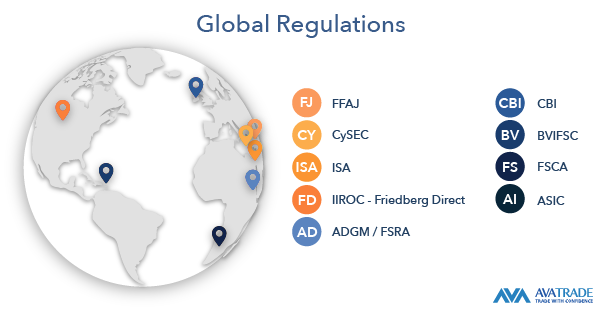
- Multiple Trading Platforms: Experience the versatility of trading cryptocurrencies across our range of user-friendly platforms, including MT4, MT5, WebTrader, and AvaTradeGO.
- CFD Trading: Trade cryptocurrency CFDs and take advantage of leverage of up to . With cryptocurrency CFDs, you have the opportunity to profit from both rising and falling markets.
- Comprehensive Educational Resources: Our Education Centre is packed with resources designed to enhance your cryptocurrency trading knowledge and skills. Learn about the unique characteristics of different cryptocurrencies and discover effective trading strategies.
- Practical Trading Resources & Tools: Make the most of AvaTrade’s practical trading resources, such as Trading Central, to uncover more opportunities in the markets. Plus, with AvaProtect, you can manage your risk exposure effectively. On top of that, AvaTrade offers free cryptocurrency trading signals integrated with WebTrader and AvaTradeGO.
- Award-winning Customer Support: Our professional and responsive customer support team is always ready to provide prompt and expert assistance.
- Demo Account Trading: Use your AvaTrade demo account to test, practice, and refine your cryptocurrency trading strategies for free and without risks. Once you're ready, switch to your real money account and start trading.
How to Trade Cryptocurrencies FAQs
How Can I trade cryptocurrencies?
Trading cryptocurrencies involves buying and selling digital currencies on a cryptocurrency exchange or trading platform. You can also trade cryptocurrency derivatives, such as CFDs, which allow you to speculate on price movements without owning the underlying asset.
Is trading cryptocurrencies safe?
How do you start trading cryptocurrencies?
How do you predict cryptocurrency prices?
Cryptocurrency prices cannot be predicted. That being said, there are indicators that may increase one’s odds of being correct. This involves analysing market trends and factors that influence price movements. This can be done through fundamental analysis, which involves evaluating news events, market trends, and other macroeconomic factors, or technical analysis, which involves studying price charts to identify patterns and trends. Using a combination of both can provide a more comprehensive prediction.
































